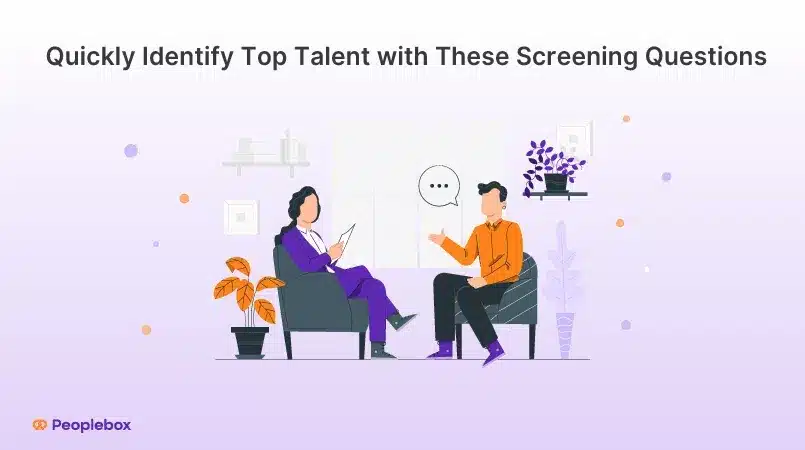TL;DR
360 performance reviews collect anonymous feedback from peers, managers, direct reports, and sometimes clients to give a holistic view of employee performance. This approach reduces bias, increases self-awareness, drives career growth, and helps organizations retain top talent.
Platforms like Peoplebox.ai streamline 360 reviews with automated surveys, Slack/Teams integration, and actionable insights.
360-degree feedback gives the true image of the performance of employees, which is the largest issue HR departments are facing at present. With this 360-degree method, you can retain your star performers and develop the team instead of relying on the assessment of a single manager.
You would’ve sensed that old-school performance review and management is like checking boxes simply for the sake of it. When your high performers suddenly quit with no notice, and your year-end reviews are simply dull data packets. What if there were a more effective approach? Read on!
What Is the 360 Performance Review?
The 360 Performance Review process is a modern approach and different from old-style performance management. Rather than depend on one manager’s point of view, this holistic method obtains anonymous performance feedback from all those who work with an employee on a regular basis.
Around 8-12 individuals fill out anonymous web-based surveys that address a range of workplace measures and behaviors. This multi-source feedback system includes feedback from employees, managers, direct reports, and sometimes even customers or clients, providing a balanced view of performance from all directions.
The market study indicates that the 360-degree feedback software market worldwide is expected to be $1.23 billion in 2025 and reach $2.49 billion by 2032 at a growth rate of 10.6%. This is quite high growth from various verified sources, indicating market sizes ranging from USD 1.5 billion in 2024, with an estimate to hit USD 3.2 billion by 2033.
How Does the 360 Review Process Work?
The 360 review process works using careful planning and well-defined objectives. Companies first need to determine what they want to accomplish – leadership growth, enhanced teamworking, or succession planning. You can start with these points in mind:
Set Up a 360 Degree Assessment Framework
Look at Adobe’s performance review strategy. When they introduced their “Check-In” in 2012 to take over from annual reviews with ongoing feedback, employee engagement improved by 30%.
Design Helpful 360 Assessment Surveys
Develop competency-based questionnaires that emphasize measurable behaviors over subjective characteristics. This way, feedback can be kept practical and actionable. Surveys need to include:
- Professional competencies (job-specific and technical skills)
- Behavioral traits (communication, cooperation, leadership)
- Interpersonal effectiveness and teamwork skills
- Performance in given role-related situations.

Why Do 360 Degree Reviews and Appraisals Beat Traditional Reviews?
360-degree reviews provide a more complete and unbiased view of employee performance, ensuring development opportunities are based on holistic insights rather than a single perspective
| Comparison Factor | 360-Degree Performance Review | Traditional Performance Review |
| Feedback Sources | Multiple sources: managers, peers, direct reports, customers | Single source: direct manager only |
| Bias and Accuracy | Reduces bias through diverse perspectives | Higher bias risk from one viewpoint |
| Employee Development | Comprehensive development insights from all angles | Limited development focus from manager alone |
| Cultural Impact | Promotes transparency and open communication | Maintains hierarchical, top-down structure |
How Does a 360-Degree Assessment Reduce Bias?
In the conventional review, there’s an individual bias that may totally affect equitable assessments. The 360-degree review alleviates this bias by considering several inputs, offering objective facts rather than the single opinion of possibly biased personal judgment.
Microsoft’s implementation of 360-degree feedback to move towards a growth mindset culture improved staff satisfaction by 40% and team collaboration measurements by 20%. This change occurred because several different angles showed blind spots that were not seen at all by single-source feedback.
How Does 360 Degree Feedback Increase Self-Awareness?
Staff get extensive feedback on numerous behaviors during 360 performance reviews, providing them with complete insights into how they engage with others in the workplace. Such specificity opens up doors to concentrated development and career progression.
A new study by Gallup shows that workers who are given frequent feedback are 3.2 times as likely to be involved in their jobs, proving the direct relationship between extensive feedback and worker involvement.
Major Advantages of 360 Feedback Programs
Firms with robust 360-degree feedback systems were 12.5% more productive, establishing the essential relationship between elaborate feedback systems and firm success.
360 Degree Evaluation Enhances Career Growth
Its influence on career growth is considerable. Research indicates that 72% of the workforce stated that they felt valued and appreciated when 360-degree feedback was provided.
Organizations that adopt these types of systems tend to enjoy a 14.9% reduction in turnover, highlighting just how much effective feedback loops do play a role in maintaining top performers.
Build Better Development Programs with Real Data
HR professionals are able to review performance data to make educated decisions on talent development and promotions. The 360-degree feedback system offers holistic information about behavioral patterns and leadership abilities frequently overlooked by conventional reviews.
Accenture’s replacement of formal performance ratings with a real-time 360 feedback process led to team productivity gains of 30%. The change enabled employees to become active contributors to their own development conversations.
| 360 Performance Review with Peoplebox.ai Get a complete view of employee performance with feedback from peers, managers, and reports. ✅Reduce bias ✅Boost self-awareness ✅Drive growth & retention Peoplebox.ai makes it easy with ready templates, Slack/Teams integration, and real-time insights. Start Your 360 Review |
How To Implement a 360-Degree Review Process? (Step-By-Step Guide)
Implementing the 360-degree review process is simpler than most companies anticipate. Your primary requirements are management support, employee acceptance to provide and accept feedback, and commitment to act on development plans.
After securing these fundamentals, the 360 feedback process more or less operates automatically using automated systems and systematic workflows. The system removes the uncertainty from performance rating by tapping into the opinions of individuals who directly work with every employee on a daily basis.
Step 1: Define Clear Review Criteria
- Create job-specific competencies derived from quantifiable behaviors.
- Define clear goals (performance rating, leadership growth, or development).
- Implement cultural sensitivity in feedback processes.
- Engage stakeholders in the development of criteria for ownership.
Step 2: Select Your Panel Strategically
- Select 8-12 reviewers from distinct workplace levels.
- Include managers, peers, direct reports, and external stakeholders(if required).
- Ensure that there is a regular interaction between reviewees and raters.
- Guide selection for constructive, well-informed feedback.
Step 3: Conduct Survey Distribution
- Communicate objectives clearly to invite honest participation.
- Create easy-to-use surveys with less completion time.
- Develop clear timelines with deadline reminders.
- Use HR tools for proper distribution and collection.
Step 4: Develop Development Action Plans
- Make arrangements for one-on-one feedback personally.
- Create customized action plans with precise, realistic objectives.
- Offer development material (training, coaching, mentoring).
- Set frequent follow-ups to monitor progress and revise development plans.
How does Peoplebox.ai work for 360-Degree Reviews?
Peoplebox.ai provides templates designed by experts and editable review forms from vast question libraries. The solution integrates with Slack and Microsoft Teams for effortless feedback gathering within current workflows, with automated reminders guaranteeing on-time participation.
Real-time rating calibration dispenses with spreadsheet dependency, and the system schedules 1:1 meetings automatically with pre-populated agendas using review
Frequently Asked Questions
What is a 360 performance review?
A 360 performance review is a modern feedback system that gathers anonymous input from multiple sources including peers, managers, direct reports, and sometimes clients to provide a complete picture of an employee’s performance.
How does 360 feedback improve employee performance?
By providing insights from multiple perspectives, 360 feedback helps employees understand strengths and areas for improvement, boosts self-awareness, and supports targeted career development.
Why is 360-degree feedback better than traditional reviews?
Traditional reviews rely on a single manager’s perspective, which can introduce bias. 360-degree feedback incorporates multiple viewpoints, reducing bias, improving accuracy, and fostering open communication.
How do companies implement 360-degree reviews?
Companies define review criteria, select 8–12 reviewers, distribute easy-to-use surveys, and create development action plans. Tools like Peoplebox.ai automate surveys, reminders, and 1:1 meeting scheduling.
Can 360 reviews help with employee retention?
Yes. Employees receiving actionable, multi-source feedback feel valued and engaged, reducing turnover and helping retain top performers.
What features should I look for in 360 feedback software?
Look for multi-source feedback collection, anonymous surveys, analytics dashboards, integration with existing tools like Slack/Teams, automated reminders, and action plan support.






